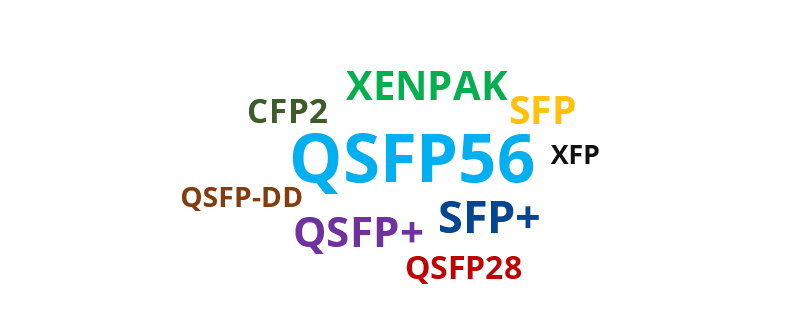
Regarding the QSFP56 package, do you know?
Date:2021-04-15Click:1072
The 200G QSFP56 and 200G QSFP-DD are two mainstream solutions for 200G optical interconnection, with QSFP56 using mainstream digital signal processors (DSPs) to help cloud data centers meet the challenges of faster optical interconnection with flexible scale and cost. This article will mainly introduce you to the 200G QSFP56 packaging technology and the differences with other QSFP plus packages.

Figure 1: Light module package type
What is the QSFP56 package?
First, let's look at the form factor of the QSFP package, which is a four-channel small hot-swappable SFP interface (QSFP) designed to replace a single-channel SFP light module with a high-density light module. The bandwidth of the QSFP optical module is higher than that of the SFP optical module.
The 40G QSFP plus and 100G QSFP28 optical modules developed on the basis of the QSFP package are beginning to be gradually applied to high-density data centers. As data center traffic continues to grow and bandwidth requirements increase, more form factors have emerged for QSFP package types, such as 200G QSFP56 and 400G QSFP56-DD.
The QSFP56 optical module is an upgraded version of the 40G QSFP plus and 100G QSFP28 optical modules, which are designed specifically for 200G Ethernet interconnects. The QSFP56 represents a transmission rate of 4x 50Gb/s to 56Gb/s in one QSFP package size. Sometimes, for convenience, the QSFP56 optical module can also be called the 200G QSFP light module. According to the transmission distance, QSFP56 optical module can be divided into QSFP56 CR, SR, DR, FR, LR and other types, can be implemented on single-mode and multi-mode fiber transmission distance.
In general, two QSFP56 optical modules are plugged into the corresponding switch port, and then connected by a single-mode or multi-mode fiber, the transmission rate of 200G can be achieved. In addition, the QSFP56 DAC/AOC high-speed cable plugged into the corresponding port, can also achieve 200G transmission. If you want to achieve a transmission rate of 2x100G or 4x50G, you can use 200G QSFP56 to 2x100G QSFP28 branch cable and 200G QSFP56 to 4x50G SFP56 branch cable.
QSFP56 vs QSFP28 vs QSFP+
In terms of name, the package types of QSFP56, QSFP28, and QSFP plus optical modules are the same, but their transmission rates, modulation techniques, interfaces, etc. are different, and the following table lists the basic parameters of these package types of optical modules:
| The type of package | year | Full name | The number of electrical channels | The number of light-mouth channels | Single-channel rate | Modulation technology | The transfer rate |
|---|---|---|---|---|---|---|---|
| QSFP+ | 2013 | 10G four-channel small hot-swappable light module | 4 | 4 | 10Gbps | NRZ | 40G |
| QSFP28 | 2016 | 28G 四通道小型可热插拔光模块 | 4 | 4 | 25Gbps | NRZ | 100G |
| QSFP56 | 2017 | 50G 四通道小型可热插拔光模块 | 4 | 4 | 50Gbps | PAM4 | 200G |
As can be seen from the table above, the light module of the QSFP56 package type can support 4x50G transmission to achieve a transmission rate of 200G. The QSFP plus optical module is an upgraded version of the QSFP optical module that can support 4x10G transmission for 10G Ethernet, 10G Fibre Channel, and QDR InfiniBand transmissions. It can reuse four channels to increase bandwidth and achieve a transmission rate of 40Gbps (10GBaud NRZ per channel). The QSFP28 optical module, like the QSFP plus optical module, includes a 4-way light transmitter and a 4-way optical receiver that supports 4x25G transmission for a 100G transmission rate.
The biggest difference between the QSFP56 package and the QSFP plus QSFP28 package is that the QSFP56 no longer takes the previous NRZ modulation technology, but adopts PAM4 modulation technology, the transmission rate of each channel can reach 50G, can also transmit more data on the existing optical fiber, more suitable for applications in the very large-scale data center network.
The shift from QSFP56 to QSFP56-DD (400G QSFP-DD) packages
With the rapid development of data center, the demand for data transmission is increasing, which is driving the network to higher bandwidth and higher density. At present, there is a new generation of 400G optical module package type - 400G QSFP-DD, where "DD" refers to dual density, that is, 400G QSFP-DD channel number from 4 to 8, can reach 400G transmission rate.
The QSFP56-DD is similar in size to the QSFP56, but it can be backward compatible with light modules in QSFP packages such as QSFP Plus, QSFP28, QSFP56, etc. In other words, the QSFP56 can operate on the QSFP56-DD port as long as the switch is supported. When the QSFP56 optical module is used on the QSFP56-DD, the switch's port will be configured to transmit at 200G instead of 400G.
Although the QSFP56-DD package is currently the most popular package type for 400G Ethernet, this does not mean that the QSFP56 package type is phased out, and for some data centers and enterprise networks that deploy 200G Ethernet, the 200G QSFP56 package type of optical module is still the ideal solution.

